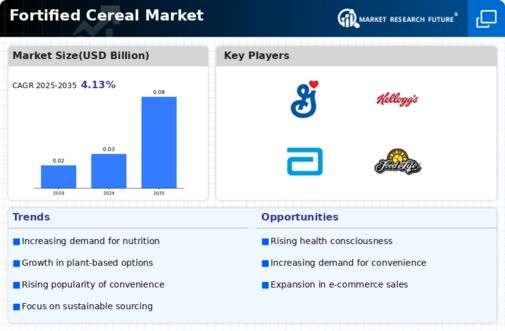Market Analysis
In-depth Analysis of Fortified Cereal Market Industry Landscape
The market dynamics of fortified cereals are driven by several factors including consumer health trends, dietary preferences, technological advancements, and regulatory standards. Fortified cereals are breakfast cereals that have been enriched with added vitamins, minerals, fiber, and other nutrients to enhance their nutritional content and health benefits. One of the primary drivers of market dynamics in the fortified cereal market is the increasing consumer demand for convenient and nutritious breakfast options. As busy lifestyles and on-the-go eating habits become increasingly common, consumers are seeking breakfast cereals that not only provide quick and convenient meal solutions but also deliver essential nutrients to support overall health and well-being.
Moreover, changing dietary habits and lifestyle trends are driving market growth within the fortified cereal segment. With growing awareness of the importance of balanced nutrition and the role of breakfast in fueling the body and mind, consumers are turning to fortified cereals as a convenient and nutrient-dense breakfast choice. Fortified cereals offer a simple way to incorporate essential vitamins, minerals, and fiber into the diet, providing a nutritious start to the day that can help meet daily nutritional requirements and support overall health.
Furthermore, technological advancements in cereal formulation and fortification techniques are contributing to market dynamics within the fortified cereal market. Manufacturers are leveraging advanced processing technologies and ingredient formulations to fortify cereals with targeted nutrients in precise amounts, ensuring optimal bioavailability and efficacy. Additionally, innovative product formulations such as multigrain blends, gluten-free options, and low-sugar varieties cater to diverse consumer preferences and dietary needs, driving market innovation and product differentiation.
Another significant factor shaping market dynamics is the influence of regulatory standards and labeling requirements. Government agencies such as the FDA (Food and Drug Administration) in the United States and the EFSA (European Food Safety Authority) in the European Union regulate the fortification of food products to ensure safety, efficacy, and accurate labeling. Manufacturers must comply with regulatory standards and obtain approval for fortification claims before marketing fortified cereals to consumers. Additionally, transparent and informative labeling practices help consumers make informed choices about the nutritional content and health benefits of fortified cereals, driving consumer trust and confidence in the market.
Moreover, market dynamics within the fortified cereal market are influenced by consumer preferences for specific health benefits and functional ingredients. For example, fortified cereals targeting heart health may contain added fiber, whole grains, and plant sterols to support cardiovascular function and reduce the risk of heart disease. Products aimed at digestive health may be fortified with prebiotics and probiotics to promote gut health and improve digestion. Understanding consumer needs and preferences for specific health benefits allows manufacturers to develop targeted fortified cereal formulations that resonate with their target audience and drive market growth.
In addition to consumer-driven factors, economic considerations such as pricing, affordability, and value perception also impact market dynamics within the fortified cereal segment. While consumers are willing to pay a premium for cereals that offer added health benefits and functional ingredients, affordability remains a key consideration, particularly for budget-conscious consumers. Manufacturers must balance product quality, pricing, and perceived value to remain competitive in the fortified cereal market and attract a wide range of consumers across different income levels.







Leave a Comment